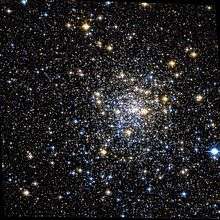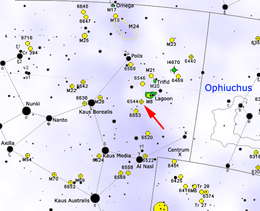NGC 6544
| NGC 6544 | |
|---|---|
 | |
| Observation data (J2000 epoch) | |
| Right ascension | 18h 07m 21s |
| Declination | −24° 59′ 50″ |
| Distance | 9450 light years |
| Apparent magnitude (V) | 9 |
| Apparent dimensions (V) | 1' |
| Physical characteristics | |
NGC 6544 is a small globular cluster visible in the constellation Sagittarius. It is magnitude 7.5, diameter 1 arc minute. It is less than 1 degree southeast of Messier 8, the lagoon nebula.
Osservazione

It locates in the western part of the constellation, on the edge of a rich star field; its location is easily recoverable as it is located just 50' towards the southeast compared to the famous Lagoon Nebula. It can also be noted with a binoculars 10×50mm as a small white spot like a misty star; with a telescope 120mm and 100× magnification around you may notice a few tiny little star, but overall the clutter is almost unsolvable. Telescopes from 200mm up and high magnification allow resolving of dozens of dim stars.
Because of its declination is rather south, this cluster can be mainly observed by observers located in southern hemisphere, although it is still observable fairly even up to medium temperate latitudes. The best time for observation in the evening sky is the one included between June and October.
History of observations
NGC 6544 was been observed for the first time by William Herschel in 1784, who watched through his 18.4 inch reflector; he described it as a fairly bright and large object, circular and resolvable into stars; in New General Catalogue provides a similar description.
Characteristics
NGC 6544 is a globular cluster of medium density, estimated value of 5 on a scale between 1 and 12; its distance is estimated at 2900 parsecs (9450 light years) from the Sun, which in its position corresponds to a distance of 6100 parsecs from the center of the Milky Way and only 100 parsecs from the galactic plane, to the point of being one of the closest globular clusters to known galactic plane. Its small angular size, equal to just under 4' for the main body storage and corresponding to just 3.2 parsecs, making it also one of the smaller globular clusters known.
In 1999 she was discovered within the cluster a pulsar in a binary system of type millisecond, cataloged as PSR J1807-2459; There are few notes variable stars part of this cluster; a 1993 study focused on the region around NGC 6544 has identified some variable stars, of which only one is found to belong in storage: it is a RR Lyrae variable with a period of 0.57 days.
Note
References
- Tirion, Rappaport, Lovi, Uranometria 2000.0, William-Bell inc. ISBN 0-943396-15-8
- Robert Burnham, Jr, Burnham's Celestial Handbook: An observer's guide to the universe beyond the solar system, vol 3, p.1556